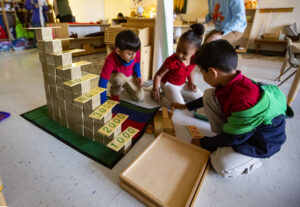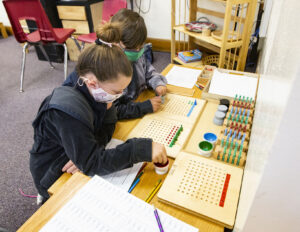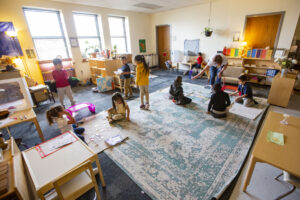Since the Ector County ISD Board of Trustees approved adding sixth grade back to Austin Montessori Elementary this coming fall, the excitement has been building.

(Jacob Ford | Odessa American)
Sixth grade was moved to middle school about five years ago. Principal Tania Hagood said this move, approved at the board’s March 23 meeting, has been in the works for several years.
This will add an estimated 45 sixth-grade students to the school. About 450 students attend Austin now and there are 23 teachers.
“… I know our teachers and our families are very passionate about Montessori and they love our campus and so just excitement for everyone involved,” Hagood said.
Adding sixth grade won’t change the number of teachers at Austin.
“Currently our staffing roster doesn’t include additional teachers, so we’ll configure those classrooms in a multi-age fashion,” Hagood said.
The campus currently has prekindergarten 3-year-olds through fifth graders with three levels — early childhood prekindergarten 3-year-olds, pre-k 4 and kindergarten; elementary 1, first, second and third grade; and elementary 2, fourth and fifth grade.
The sixth grade would be added to the elementary 2 level.
In the future, and if there’s interest, Hagood can see expanding up to eighth grade.
“… That I think is a natural progression from adding sixth grade …,” she said.
A family meeting will be held with parents and fifth graders to see what their options are in April. Families have the option to attend their zone sixth grade campus or to stay at Austin, “so we want to be able to answer all of their questions,” Hagood said.

(Jacob Ford | Odessa American)
She added that the Montessori teaching method works best when multiple grade levels are taught together.
At the early childhood level, there is a teacher and teaching assistant. In elementary 1, there is a half day assistant, she said.
“It’s based on the philosophy and work of Dr. Maria Montessori. She … devoted her life to studying children and she found that students work best in that multi-age fashion because it’s their plane of development. There are many benefits to working in a multi-age classroom. Students get to remain with the teacher for more than one year, so that allows the teacher to accelerate or remediate learning rather quickly. They don’t have to learn students in August because they already know them,” Hagood said.
She added that there are schools that use something called looping where they may move up with their students from fourth to fifth grade and then they loop back down.
“But this is pretty standard where we have the multiple age groups in the classroom … So another benefit is that students get to be that leader at that third year. And so our kindergarteners, our third grade students and our sixth grade students are the leaders of the campus. And so, one of their responsibilities or roles is to model for other students and mentor other students and teach other students as well,” she added.
Hagood said people can remember back to their childhood where they may have been that quiet child, a studious child or a child that had more energy.
“Those students get to watch other students and look forward to becoming those leaders, and so it really is a special thing,” she added.
Even with the age differences in the classroom, Hagood said the students get along fabulously because of the peace curriculum.

(Jacob Ford | Odessa American)
“… Just walking around, you may see that students work and collaborate really well together. And that’s just part of the model. … Our counselor does I Can Lab, so she meets with all of our students, first through fifth grade, weekly to do different kinds of lessons, whether it’s goal setting or bullying prevention. And so we have a pretty great group of kids,” Hagood said.
“Maria Montessori was good friends with Gandhi. They lived in a time of war and they wrote letters to one another. They found, through their shared experiences, that really the goal of education is world peace. That’s a huge component in Montessori is to make people peacemakers of the world and just really good human beings,” Hagood said.
It takes a lot of commitment to become a Montessori teacher and the training is expensive.
“When those teachers are ready to do that, we want them to be enrolled because it does make a huge difference in the way you understand Montessori and really how you practice and implement the program,” Hagood said.
“Usually when you hear about Montessori, you just know that it’s something different and special so it takes time to really know more. The more you know about it, most often, the more you fall in love with it and the more you want to know about it,” she added.
When students come to school at 3 years old, they learn how to navigate through school, how to go through the day, work with others, collaborate, work on communicating and learning how to share their wants and needs with other people and other people in the classroom.
She added that because the program is so special, the school is always looking for teachers and staff who love education, but want to do something different and innovative.
The campus doesn’t have much turnover, but Hagood said there are teachers and staff that have higher goals and they are always encouraged because they are going to be “a blessing in another place.”
“We’re looking for those people to come and join us to do … this important work,” Hagood said.
She said most people that come to Austin have been teaching for a few years, know the state standards and how to manage a classroom.
“They’re just looking for something different,” she said. “And so when they’re looking for something different and special those are the people that we’re looking for to come and do this special work and I think the more you know about it, the more you just fall in love with it.”
Amy Richter, who teaches fourth and fifth grade, is in her 14th year at Austin. She noted that sixth grade is an important part of the program.
“We saw the difference right away that it was like an imbalance because our sixth graders were our leaders in our classroom. They really helped the new fourth graders that are coming in because they’re coming into a new environment. They’ve been with another teacher for three years. They’re coming in as brand-new fourth graders. They struggle a little bit. They see all these brand-new lessons that are in the classroom and the curriculum’s changing. Those sixth graders are able to help those fourth graders,” Richter said. “They take them under their wing … They become kind of like tutors in the classroom, so it really helps them to be successful having that peer model. They really look up to those sixth graders. That’s the most exciting part about it is seeing that relationship. …”


